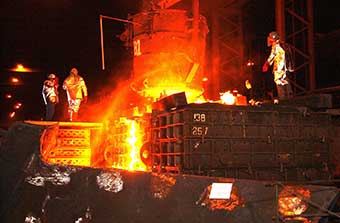 The steel making process is perhaps the most dramatic and amazing industrial process mankind has ever developed. From the initial explosions required to release iron ore from the earth to the fiery, scorching steps that happen in the steel mill, the jobs involved in this process have traditionally been challenging and demanding. Thanks to advances in technology, the steel making process looks much different today than it did just a decade or so ago. Many of the rigorous jobs that were once performed by intrepid steel mill workers have been replaced by automated processes. In this month’s post, we are going to take a look at some of the toughest jobs that were once performed in the steel mill.
The steel making process is perhaps the most dramatic and amazing industrial process mankind has ever developed. From the initial explosions required to release iron ore from the earth to the fiery, scorching steps that happen in the steel mill, the jobs involved in this process have traditionally been challenging and demanding. Thanks to advances in technology, the steel making process looks much different today than it did just a decade or so ago. Many of the rigorous jobs that were once performed by intrepid steel mill workers have been replaced by automated processes. In this month’s post, we are going to take a look at some of the toughest jobs that were once performed in the steel mill.
Steel mill jobs included a wide range of tasks including the operation of furnaces, molding equipment, rolling and finishing machines, and more. The product they made came in the form of steel slabs, bars, sheets, billets, rods, wires, and plates. These products were used to build much of the world around us, from vehicles and buildings to tools and equipment.
The concept of metal working has been around for thousands of years, but was a relatively rare and difficult process. By the 18th and 19th centuries, steel production took off thanks to the development of the Bessemer process and subsequent industrial revolution. Modern basic oxygen furnaces and electric arc furnaces enable the production of steel at extremely high rates, making steel one of the most used and recycled materials in today’s civilization.
Doing the work
The process of making iron and steel in the mill begins with the melting of iron in huge blast furnaces, which are water-cooled steel cylinders that are heated by blasts from other dome-topped cylinders known as stoves. These furnaces can often be over 10 stories high. Before automation, many jobs were involved in steel mill processes.
Skip operators were responsible for loading the raw materials into the furnace. Raw materials, including iron ore, coke, and limestone, were conveyed via railroad cars to the top of the furnace and dumped into the furnace.
Stove tenders had the job of heating the air in the stoves until it was the right temperature, then opening valves to blast the heated air into the furnace. The materials must reach temperatures in excess of 3000° F to melt, so this was inherently a dangerous job. The limestone was used to purify the iron. The pure molten iron settled at the bottom of the furnace, while the limestone drew out the impurities and floated on the top as slag, which had to be removed.
Furnace operators were responsible for regulating the temperature and flow of coolant in furnaces. Charging-machine operators used mechanical arms to pick up containers full of iron and other elements and deposit them into the furnace. When the hot steel was ready for transformation hot -metal crane operators and steel pourers worked together to mold the steel into blocks called ingots.
Charger operators were responsible for moving the steel ingots into soaking pits, where they were reheated for rolling. The steel stayed heated at temperatures of up to 2450° F for up to 14 hours. At this point the ingots were ready for rolling or shaping into billets, blooms, and slabs. Bottom makers did the job of relining the bottom of the soaking pits with coke oxide dust to prevent the formation of oxide scale on the next batch of ingots. Rail-tractor operators were tasked with moving the hot ingots and slabs from soaking pits to the conveyors that delivered them to finishing mills.
Continuous Casting – A New Era in Steel Mill Manufacturing
Continuous casting, or strand casting, provides a much more efficient process for turning molten steel into semi-finished steel for rolling in finishing mills. This process provides a much higher yield than the stationary molds used to create ingots. In the process of continuous casting, a ladle is used to transfer liquid steel into an intermediate vessel called a tundish. The bottom of the tundish has one or more holes with slide gates or stopper rods for controlling the metal flow. As molten metal is cast through a mold, it takes the two dimensional profile of the mold, but its length is continuous. As new molten metal continues to be supplied to the mold at a predetermined and precisely calculated rate, the casting keeps moving downward and increasing in length until it is cut into billets, blooms, or slabs. First introduced in the 1950’s, continuous casting as a steel making process has continually evolved, changing the way many jobs are done in the steel mill, as have a wide range of other advances in equipment and control technology.
In the rolling mill, massive steel rollers are used to press the preformed steel into a variety of forms and shapes. Setting up the rollers for steel to pass through is the responsibility of roll builders. Working with the roll builders, the guide setters adjust rollers to the specifications required for the shape or form they are creating.
While some of the steel from here will go to foundries for parts fabrication, most is sent to finishing mills to be made into sheet steel, wire, and other types of bulk steel. At the finishing mills, a wide range of operators specialize in transforming the steel into a wide variety of forms for specific industry needs.
To see some examples of some of the steel mill jobs described in this post, look for the Steel Mill Worker episode of Dirty Jobs with Mike Rowe, which originally aired in 2008. (You must log into your television service provider account to watch episodes of this Discovery Channel program.) In the meantime, you can check out this steel making video published by the Steel Plant Museum of Western New York.
Xtek is proud to be a part the United States steel producing tradition, serving a comprehensive range of steel mill needs. Our commitment is to continuing this legacy by providing the best quality and highly dependable components to keep the steel industry going strong.
